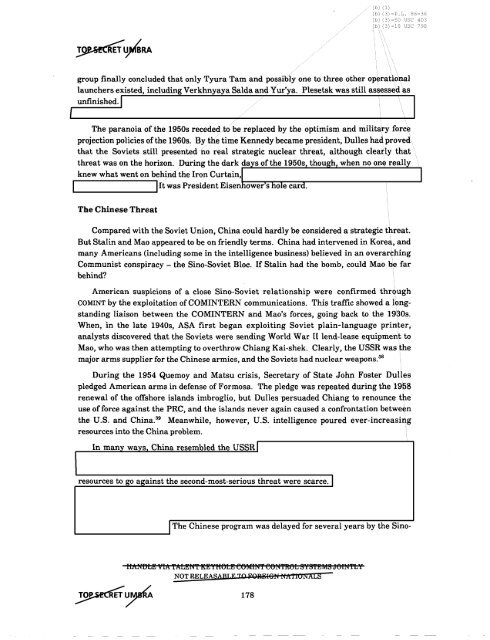American Cryptology during the Cold War - The Black Vault
American Cryptology during the Cold War - The Black Vault
American Cryptology during the Cold War - The Black Vault
You also want an ePaper? Increase the reach of your titles
YUMPU automatically turns print PDFs into web optimized ePapers that Google loves.
Ib) (1)<br />
Ib) (3) -P.L. 86-36<br />
Ib) (3) -50 USC 403<br />
Ib) (3) -18 USC 798<br />
group finally concluded that only Tyura Tam and possibly one to three o<strong>the</strong>r operational<br />
launchers existed, including Verkhnyaya Salda andYur'ya. Plesetsk was still assessed as<br />
unfinished.I<br />
I<br />
<strong>The</strong> paranoia of <strong>the</strong> 1950s receded. to be replaced by <strong>the</strong> optimism and military force<br />
projection policies of<strong>the</strong> 1960s. By <strong>the</strong> time Kennedy became president, Dulles had proved<br />
that <strong>the</strong> Soviets still presented/no real strategic nuclear threat, although clearly that<br />
threat was on <strong>the</strong> horizon. During <strong>the</strong> dark days of<strong>the</strong> 1950s, though, when no one really<br />
knew what went on behind<strong>the</strong> Iron Curtainf<br />
lIt was President Eisenli-ow=e~r~'s"'Th~o"'Tl-e-c"':"'a-rd"'.--------""""---<br />
I<br />
<strong>The</strong> Chinese Threat<br />
Compared with <strong>the</strong> Soviet Union, China could hardly be considered a strategic threat.<br />
But Stalin and Mao appeared to be on friendly terms. China had intervened in Korea, and<br />
many <strong>American</strong>s (including some in <strong>the</strong> intelligence business) believed in an overarehing<br />
Communist conspiracy - <strong>the</strong> Sino-Soviet Bloc. If Stalin had <strong>the</strong> bomb, could Mao be far<br />
behind?<br />
<strong>American</strong> suspicions of a close Sino-Soviet relationship were confirmed through<br />
COMINT by <strong>the</strong> exploitation ofCOMINTERN communications. This traffic showed a longstanding<br />
liaison between <strong>the</strong> COMINTERN and Mao's forces, going back to <strong>the</strong> 1930s.<br />
When, in <strong>the</strong> late 1940s, ASA first began exploiting Soviet plain-language printer,<br />
analysts discovered that <strong>the</strong> Soviets were sending World <strong>War</strong> II lend-lease equipment to<br />
Mao, who was <strong>the</strong>n attempting to overthrow Chiang Kai-shek. Clearly, <strong>the</strong> USSR was <strong>the</strong><br />
major arms supplier for <strong>the</strong> Chinese armies, and <strong>the</strong> Soviets had nuclear weapons. S8<br />
During <strong>the</strong> 1954 Quemoy and Matsu crisis, Secretary of State John Foster Dulles<br />
pledged <strong>American</strong> arms in defense of Formosa. <strong>The</strong> pledge was repeated <strong>during</strong> <strong>the</strong> 1958<br />
renewal of <strong>the</strong> offshore islands imbroglio, but Dulles persuaded Chiang to renounce <strong>the</strong><br />
use offorce against <strong>the</strong> PRC, and <strong>the</strong> islands never again caused a confrontation between<br />
<strong>the</strong> U.S. and China. 39 Meanwhile, however, U.S. intelligence poured ever-increasing<br />
resources into <strong>the</strong> China problem.<br />
In manv wavs China resembled <strong>the</strong> USSR I<br />
resources to go against <strong>the</strong> second-most-serious threat were scarce. I<br />
I<strong>The</strong> Chinese program was delayed for several years by <strong>the</strong> Sino-<br />
1...- ---'<br />
II2\:!'i'BLE VIA TALEH"f KE i MeLE eeMHofT eetfffteL SYSTEMS JeHof'fLY<br />
NOT RELEASABLE TO FQREI8H Iffl IiONALS<br />
178
















